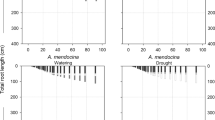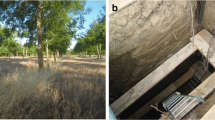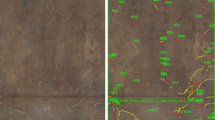Abstract
Pappophorum vaginatum is the most abundant C4 perennial grass desirable to livestock in rangelands of northeastern Patagonia, Argentina. We hypothesized that (1) defoliation reduce net primary productivity, and root length density and weight in the native species, and (2) root net primary productivity, and root length density and weight, are greater in P. vaginatum than in the other, less desirable, native species (i.e., Aristida spegazzinii, A. subulata and Sporobolus cryptandrus). Plants of all species were either exposed or not to a severe defoliation twice a year during two growing seasons. Root proliferation was measured using the cylinder method. Cylindrical, iron structures, wrapped up using nylon mesh, were buried diagonally from the periphery to the center on individual plants. These structures, initially filled with soil without any organic residue, were dug up from the soil on 25 April 2008, after two successive defoliations in mid-spring 2007. During the second growing season (2008–2009), cylinders were destructively harvested on 4 April 2009, after one or two defoliations in mid-and/or late-spring, respectively. Roots grown into the cylinders were obtained after washing the soil manually. Defoliation during two successive years did reduce the study variables only after plants of all species were defoliated twice, which supported the first hypothesis. The greater root net primary productivity, root length density and weight in P. vaginatum than in the other native species, in support of the second hypothesis, could help to explain its greater abundance in rangelands of Argentina.
Similar content being viewed by others
References
AOAC (Association of Official Agricultural Chemists). 1965. Official Methods of Analysis of the Association of Official Agricultural Chemists, 10th ed. Washington DC: Association of Official Agricultural Chemists.
Briske D D, Richards J H. 1995. Plant responses to defoliation: a physiological, morphological and demographic evaluation. In: Bedunah D J, Sosebee R E. Wildland Plants: Physiological Ecology and Developmental Morphology, Denver: Society for Range Management, 635–710.
Busso C A. 1997. Towards an increased and sustainable production in semiarid rangelands of Central Argentina: two decades of research. Journal of Arid Environments, 36: 197–210.
Cabrera A L. 1976. Phytogeographical regions of Argentina. In: Ferreira Sobral E F. Argentinian Encyclopedia of Agriculture and Gargening. Buenos Aires: ACME.
Caldwell M M, Richards J H. 1986. Competing root systems: morphology and models of absorption. In: Givnish T J. On the Economy of Plant Form and Function. Cambridge: Cambridge University Press, 251–273.
Caldwell M M, Manwaring J H, Durham S L. 1991a. The microscale distribution of neighboring plant roots in fertile soil microsites. Functional Ecology, 5: 765–772.
Caldwell M M, Manwaring J H, Jackson R B, 1991b. Exploitation of phosphate from fertile soil microsites by three Great Basin perennial when in competition. Functional Ecology, 5: 757–764.
Casper B B, Jackson R B. 1997. Plant competition underground. Annual Review of Ecology and Systematics, 28: 545–570.
Crick J C, Grime J P. 1987. Morphological plasticity and mineral nutrient capture in two herbaceous species of contrasted ecology. New Phytologist, 107: 403–414.
Di Rienzo J A, Casanoves F, Balzarini M G, et al. 2009. InfoStat. INFOSTAT Group. Argentina: National University of Córdoba.
Distel R A, Bóo R M. 1996. Vegetation states and transitions in temperate semiarid rangelands of Argentina. In: West E N. Proceeding of Vth International Rangeland Congress. Rangelands in a Sustainable Biosphere Society for Range Management, Salt Lake City, 117–118.
Dunn J P, Frommelt K. 1998. Effects of belowground herbivory by Diabrotica virgofera (Coleoptera) on biomass allocation and carbohydrate storage of mayze. Applied Soil Ecology, 7: 213–218.
Eissenstat D M, Caldwell M M. 1989. Invasive root growth into disturbed soil of two tussock grasses that differ in competitive effectiveness. Functional Ecology, 3: 345–353.
Evans G R, Tisdale E W. 1972. Ecological characteristics of Aristida longiseta and Agropyron spicatum in west-central Idaho. Ecology, 53: 37–142.
Fiala K, Tůma I, Holub P. 2012. Interannual variation in root production in grasslands affected by artificially modified amount of rainfall. The Scientific World Journal, doi: 10.1100/2012/805298.
Fitter A H. 1976. Effects of nutrient supply and competition from other species on root growth of Lolium perenne in soil. Plant and Soil, 45: 177–189.
Fowler N L. 1986. The role of competition in plant communities in arid and semiarid regions. Annual Review of Ecology and Systematics, 17: 89–110.
Giorgetti H D. 1995. Conference on cattle raising in shrublands. Chacra Experimental de Patagones, Viedma, Argentina. 56.
Giorgetti H D, Montenegro O A, Rodríguez G D, et al. 1997. The comparative influence of past management and rainfall on range herbaceous standing crop in east-central Argentina: 14 years of observations. Journal of Arid Environments, 36: 623–637.
Giorgetti H D, Montenegro O A, Rodríguez G D, et al. 1998. Effects of previous managements in the Phytogeographical Province of the Monte: plant density. In: 22nd Argentinian Congress of Animal Production, Córdoba, Argentina, 101.
Giorgetti H D, Montenegro O A, Rodríguez G D, et al. 1999. Effects of previous managements in the Phytogeographical province of the Monte: percentage cover. In: 19th Meeting of the Argentinian Association of Ecology. Tucumán, Argentina, 100.
Giorgetti H D, Montenegro O A, Rodríguez G D, et al. 2000a. Frequency of herbaceous and woody species in rangelands of Central Argentina recovering from disturbances. In: 23rd Argentinian Congress of Animal Production, Corrientes, Argentina, 138–139.
Giorgetti H D, Manuel Z, Montenegro O A, et al. 2000b. Phenology of some herbaceous and woody species in central, semiarid Argentina. Phyton, International Journal of Experimental Botany, 69: 91–108.
Giorgetti H D, Busso C A, Montenegro O A, et al. 2006. Cattle raising in central, semiarid Argentina. Rangelands, 28: 32–36.
Gittins C, Busso C A, Becker G, et al. 2010. Defoliation frequency affects morphophysiological traits in the bunchgrass Poa ligularis. Phyton, International Journal of Experimental Botany, 79: 55–69.
Hodgkinson K C, Ludlow M M, Mott J J, et al. 1989. Comparative responses of the savanna grasses Cenchrus ciliaris and Themeda triandra to defoliation. Oecologia, 79: 45–52.
Ivans C Y, Leffler A J, Spaulding U, et al. 2003. Root responses and nitrogen acquisition by Artemisia tridentata and Agropyron desertorum following small summer rainfall events. Oecologia, 134: 317–324.
Jackson R B, Caldwell M M. 1993. The scale of nutrient heterogeneity around individual plants and its quantification with geostatistics. Ecology, 74: 612–614.
Kaspar T C, Ewing R P. 1997. ROOTEDGE: software for measuring root length from desktop scanner images. Agronomy Journal, 89: 932–940.
Kilcher M R, Looman J. 1983. Comparative performance of some native and introduced grasses in southern Saskatchewan, Canada. Journal of Range Management, 36: 654–657.
Páez A, Busso C A, Montenegro O A, et al. 2005. Seed weight variation and its effects on germination in Stipa species. Phyton, International Journal of Experimental Botany, 1–14.
Quinn J A, Ward R T. 1969. Ecological differentiation in sand dropseed (Sporobolus cryptandrus). Ecological Monographs, 39: 61–78.
Saint Pierre C, Busso C A. 2006. Competitive ability and defoliation tolerance in Stipa clarazii, Stipa tenuis and S. ambigua. Phyton, International Journal of Experimental Botany, 75: 21–30.
Saint Pierre C, Busso C A, Montenegro O A, et al. 2002. Root proliferation in perennial grasses of low and high palatability. Plant Ecology, 165: 161–169.
Schacht W H, Smart A J, Anderson B E, et al. 1998. Growth responses of warm-season tallgrasses to dormant-season management. Journal of Range Management, 51: 442–446.
Shinoda M, Nachinshonhor G U, Nemoto M. 2010. Impact of drought on vegetation dynamics of the Mongolian steppe: a field experiment. Journal of Arid Environments, 74: 63–69.
Silver W L, Miya R K. 2001. Global patterns in root decomposition: comparisons of climate and litter quality effects. Oecologia, 129: 407–419.
Sokal R R, Rohlf F J. 1987. Introduction to Biostatistics. 2nd ed. New York: Freeman.
St John T V, Coleman D C, Reid C P P. 1983. Growth and spatial distribution of nutrient-absorbing organs: selective exploitation of soil heterogeneity. Plant and Soil, 71: 487–493.
Svejcar T, Angell R, Bradford J A, et al. 2008. Carbon fluxes on North American rangelands. Rangeland Ecology and Management 61: 465–474.
Torres Y A. 2011. Morphophysiological characteristics and forage production in native, introduced and naturalized warm-season perennial grasses of the center of Argentina. Ph.D. Thesis, Bahía Blanca: Universidad Nacional del Sur.
Valentine J F. 1990. Grazing Management. San Diego: Academic Press, 533.
Wilks S S. 1932. Certain generalizations in the analysis of the variance. Biometrika, 24: 471–494.
Williams T E, Baker H K. 1957. Studies on the root development of herbage plants. I. Techniques of herbage root investigations. Journal of the British Grassland Society, 12: 49–55.
Author information
Authors and Affiliations
Corresponding author
Additional information
From the seventh author onward, all authors contributed equally to this research work.
Rights and permissions
About this article
Cite this article
Torres, Y.A., Busso, C.A., Montenegro, O.A. et al. Root proliferation in native perennial grasses of arid Patagonia, Argentina. J. Arid Land 6, 195–204 (2014). https://doi.org/10.1007/s40333-013-0201-z
Received:
Revised:
Accepted:
Published:
Issue Date:
DOI: https://doi.org/10.1007/s40333-013-0201-z




